In this post, you’ll learn exactly how to create and implement an effective SaaS SEO strategy—step by step.
This is the same strategy we’ve used to grow our own blog to over 1.5 million organic search visitors around the world per month.
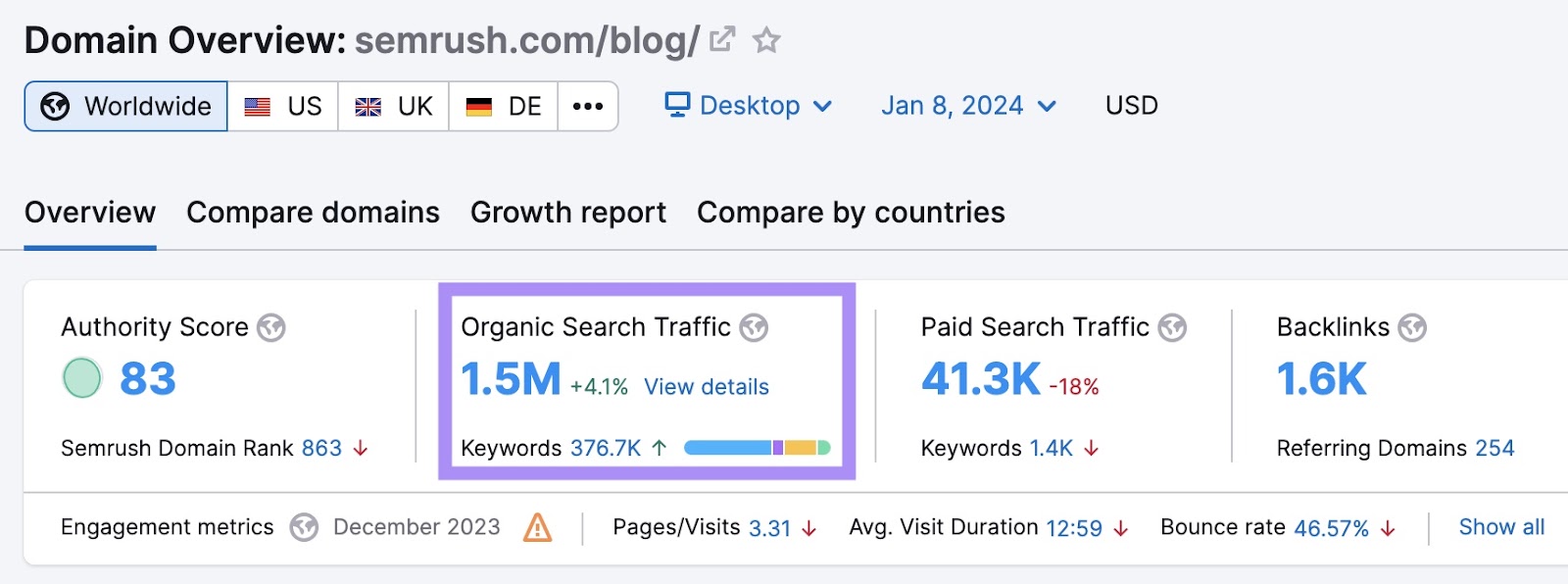
So if you want to get higher Google rankings, you’ll **** the actionable steps in this guide.
Let’s get started.
What Is SaaS SEO?
SaaS SEO is the process of optimizing your SaaS website to improve its visibility and ranking on search engines like Google and Bing. To attract more organic traffic, leads, and customers who are interested in the software solution the SaaS company offers.
It involves implementing different SEO techniques, such as keyword research, technical SEO (optimizing your site for search engines and the user experience), and link building (gaining links that point to your site)—and requires a SaaS-specific approach.
SaaS SEO can help you:
- Attract potential customers
- Build trust and authority
- Improve conversion rates
- Reduce customer acquisition costs
And more.
Why SEO Is Important for SaaS Businesses
SEO helps SaaS businesses reach and attract potential customers looking for software solutions.
Compared to most other types of businesses, SaaS companies rely more heavily on their websites to showcase their products, features, benefits, pricing, and testimonials.
Which means:
Having a high-ranking site that provides relevant and valuable information is crucial for generating leads, conversions, and revenue.
Here are some of the main benefits of SEO for SaaS companies.
Scale Growth Exponentially
SEO can drive consistent and qualified organic traffic to your site.
Organic traffic is traffic that comes from unpaid search results. And it’s valuable because it represents visits coming from people who are actively interested in the topics surrounding your business and offering.
As you create more content, your site ranks for more keywords. And you can attract more traffic from different regions, countries, and languages.
Which can help you expand your customer base and increase your global presence.
Imagine this at scale.
The more high-quality SEO content you create, the more traffic you’ll likely drive. And this is exactly one of the techniques SaaS companies use for growth (more on that below).
Reduce Customer Acquisition Costs
SEO can reduce customer acquisition costs (CAC) and increase customer lifetime value (CLV).
CAC is the money you spend to acquire a new customer. And CLV is the money you earn from a customer over their entire relationship with your business.
And SEO is one of the most cost-effective strategies that lower your CAC and increase your CLV.
Why?
Because in pay-per-click (PPC) search campaigns like the one below, you pay for every single click to your website. Drive more clicks, pay more money.
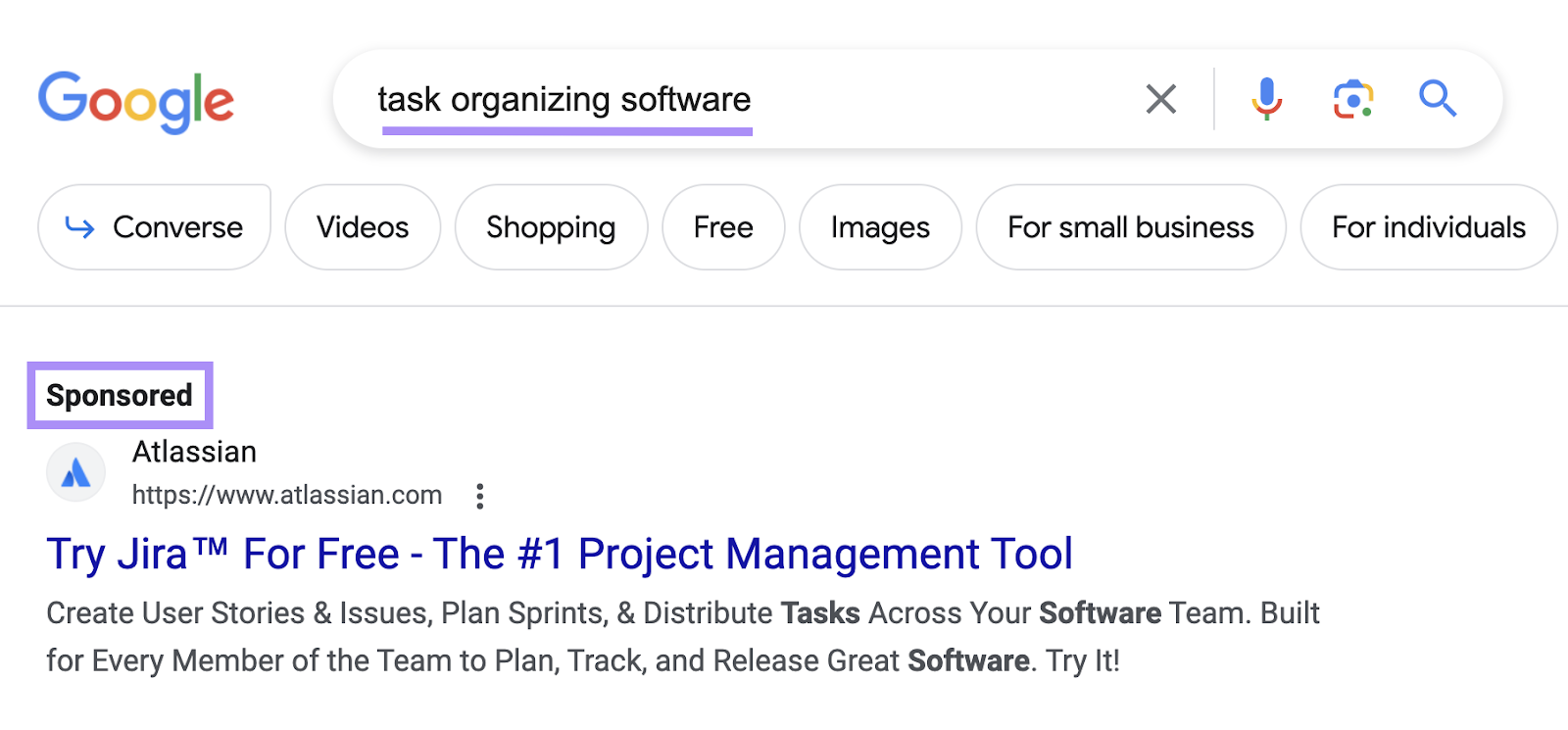
SEO, on the other hand, is quite the opposite. The cost per acquisition is initially high, but continuously drops as growth compounds over time.
While SEO requires ongoing investment, these costs don’t increase with every click.
Further reading: The ROI of SEO: How to Measure SEO ROI (With Formulas)
Convert Customers from Other Channels
SEO can complement and enhance your other marketing channels. Such as social media, email, or paid ads.
How?
It can provide additional touchpoints and opportunities for prospects who already recognize you to interact with your brand.
For example, you can use SEO to drive traffic to high-converting pages focused on keywords your customers are likely to search after they’ve seen your Google ads and LinkedIn posts. And then use those pages to persuade and convert visitors into leads or customers.
How Is SaaS SEO Different?
SEO for SaaS companiesis different from regular SEO in two main ways:
First, SaaS SEO is all about personas and problems.
You need to know who your target customers are, what they struggle with, and how your software can help them.
Second, SaaS SEO is often more about conversions than traffic.
You’re not selling a one-off product. You’re selling a long-term solution. So, you need to optimize your site and content for signups—not just clicks.
How do you do that?
By using different types of content (like case studies, demos, and free trials) to show your prospects the value and benefits of your software. Across the entire customer life cycle.
SaaS SEO and the Marketing Funnel
In SaaS SEO, it’s important to understand the different stages of the marketing funnel. And how to target the right keywords for each stage.
The marketing funnel is a model that describes the customer journey from awareness to purchase in three main phases.
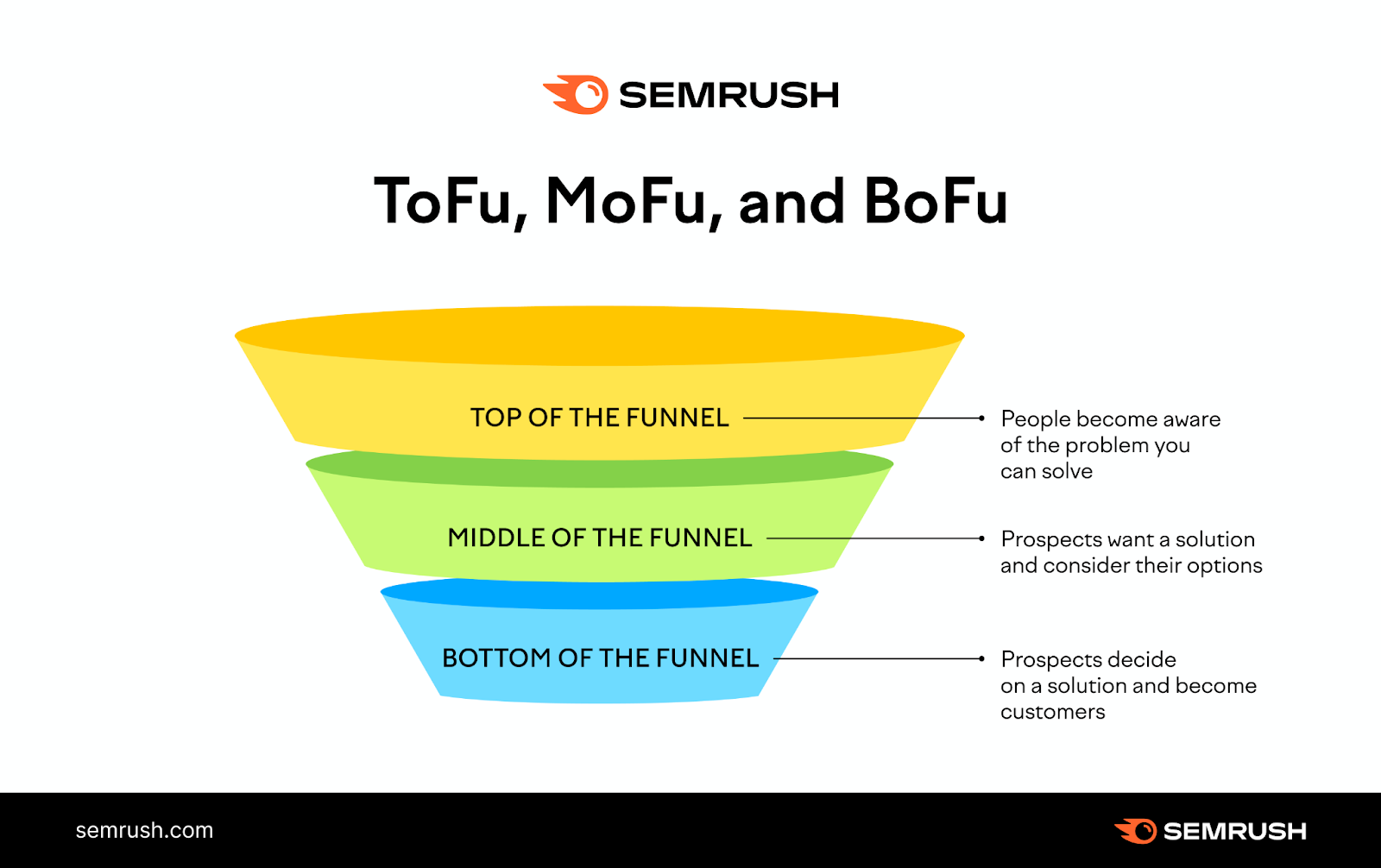
And if you align your SaaS SEO strategy with the marketing funnel, you can attract more qualified leads, nurture them with relevant content, and convert them into paying customers.
Let’s look at the different types of keywords across the funnel.
We’ll use customer relationship management (CRM) software company Pipedrive as an example:
Top-of-the-Funnel Keywords for SaaS
Top-of-the-funnel (ToFu) keywords are search queries people use when they’re looking for a solution to a problem or need.
They’re not necessarily aware of your product or brand, but they are interested in learning more about the topic.
For Pipedrive, a good example of some ToFu keywords they’re ranking for are:
- “sales pipeline”
- “gross sales”
- “gross sales vs net sales”

Someone searching for these keywords isn’t looking for Pipedrive, specifically. But they’re likely working in sales and browsing for a solution Pipedrive offers.
The goal behind targeting ToFu keywords is to generate awareness and interest in your product category. And to educate prospects about the benefits of your solution.
You should create content that answers their questions, provides value, and builds trust.
Some types of content that work well for ToFu keywords are:
- Blog posts
- Ebooks
- Guides
- Videos
Middle-of-the-Funnel Keywords for SaaS
Middle-of-the-funnel (MoFu) keywords are search queries prospects use when they’re evaluating options and comparing features and benefits.
They’re aware a solution exists, but aren’t ready to buy yet. They’re looking for more information and guidance to help them make a decision.
For Pipedrive, this means keywords like:
- “simple CRM”
- “CRM experience”
- “format of a business email with an example”
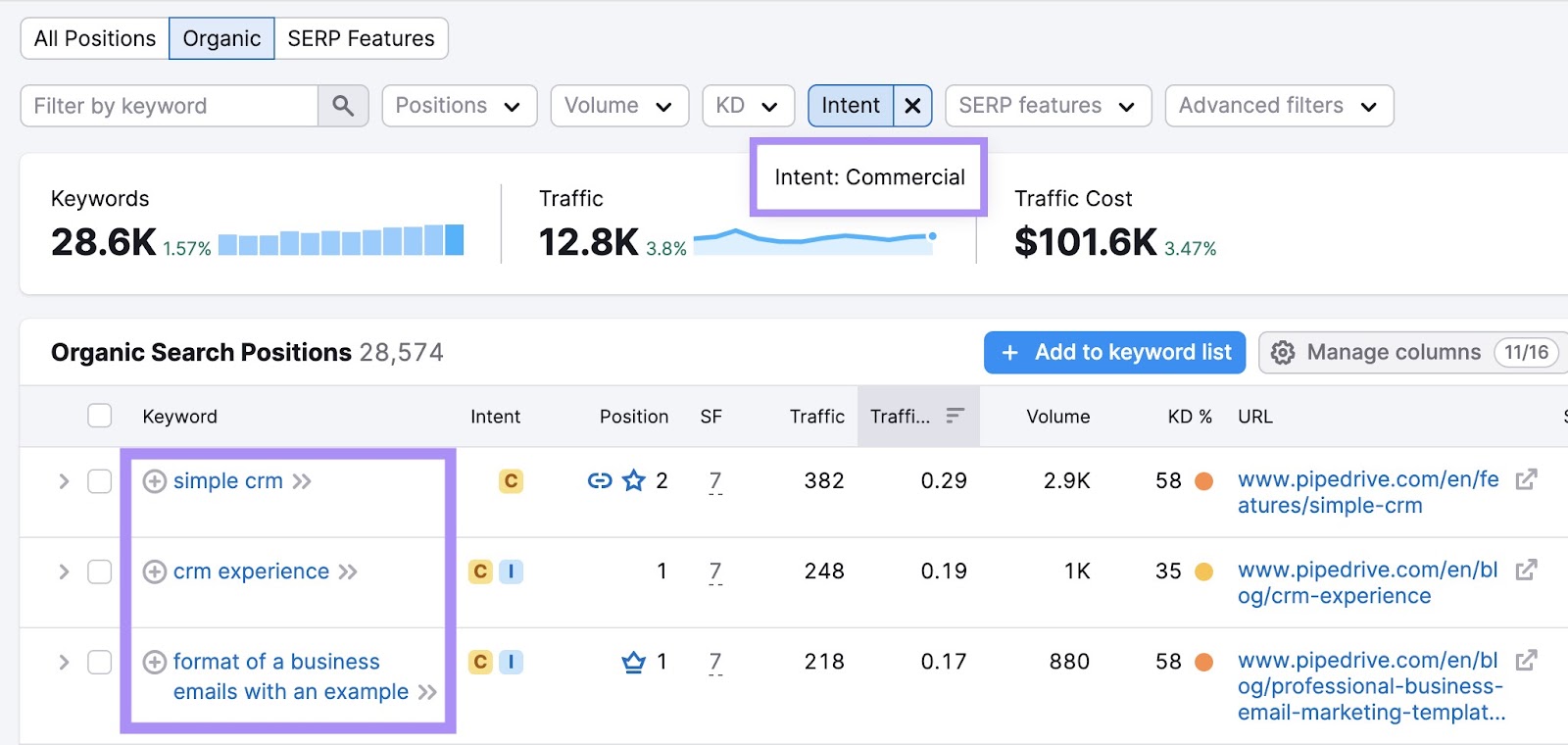
The goal behind targeting MoFu keywords is to generate consideration for your product. And to persuade prospects that your solution is the best fit for their needs.
You should create content that showcases your product’s value proposition, differentiators, and success stories.
Some types of content that work well for MoFu keywords include:
- Case studies
- Testimonials
- Product features
- Demos
Bottom-of-the-Funnel Keywords for SaaS
Bottom-of-the-funnel (BoFu) keywords are search queries prospects use when they’re ready to buy or sign up for your product.
They know a solution exists, and they know who provides it. They just need a final push or incentive to take action.
For Pipedrive, this means focusing on keywords like:
- “pipedrive pricing”
- “pipedrive quickbooks integration”
- “pipedrive forms”

The goal behind targeting BoFu keywords is to generate conversions and sales for your product. And to overcome any objections or doubts your prospects might have.
You can create content that reinforces your product’s benefits, offers discounts or bonuses, and provides social proof and guarantees.
Some types of content that work well for BoFu keywords are:
- Landing pages
- Sales pages
- FAQs
A 9-Step Plan to Create Your SaaS SEO Strategy
Here’s a step-by-step SaaS SEO strategy you can use to boost your organic traffic, leads, and conversions.
1. Set Your Goals and KPIs
Setting goals and key performance indicators (KPIs) is the most important part of any SEO strategy, SaaS or not.
You need to have a clear idea of what you want to achieve and how you’ll measure progress.
First, your goals.
Goals are the big-picture outcomes you want to achieve with SEO, such as:
- Boosting brand awareness and authority
- Attracting more qualified leads and customers
- Lowering customer acquisition costs and increasing customer lifetime value
- Educating and engaging your target audience with valuable content
KPIs are the specific metrics that show how well your SEO efforts are working. And how close you are to your goals.
For example:
- Organic traffic: How many people visit your site from search engines
- Organic conversions: How many people take a desired action on your site. Like signing up for a free trial, requesting a demo, or subscribing to your newsletter.
- Organic rankings: How high your website ranks in the search engine results pages (SERPs) for your target keywords
- Organic click-through rate (CTR): The percentage of people click on your site in the SERPs
- Organic bounce rate: The percentage of people who leave your site without engaging with the content
- Organic retention rate: The percentage of people who come back to your site after their first organic visit
- Organic revenue: How much money your site generates from organic sources
Think about your business goals. And which KPIs can help show your progress. It’ll help you have a clear sense of direction and a way to measure success.
Further reading: SEO KPIs: 12 KPIs for SEO to Track & Measure
2. Define Your Customer Personas
The next step in SaaS SEO is to figure out who your target audience is.
And the best way to do that is to do research and create customer personas.
Customer personas are fictional characters that represent your ideal customers. They include details like:
- Demographics: age, gender, location, education, income, etc.
- Psychographics: interests, hobbies, values, attitudes, etc.
- Behaviors: online habits, search patterns, social media usage, etc.
- Needs: problems, challenges, goals, desires, etc.
And they’re important for SaaS SEO.
Why?
Because they help you understand who your target audience is, what they’re looking for, and how they make decisions.
Which can help you create content that matches their search intent, solves their problems, and guides them through the buyer’s journey.
Start by having a customer persona template you can fill out. Like this one:
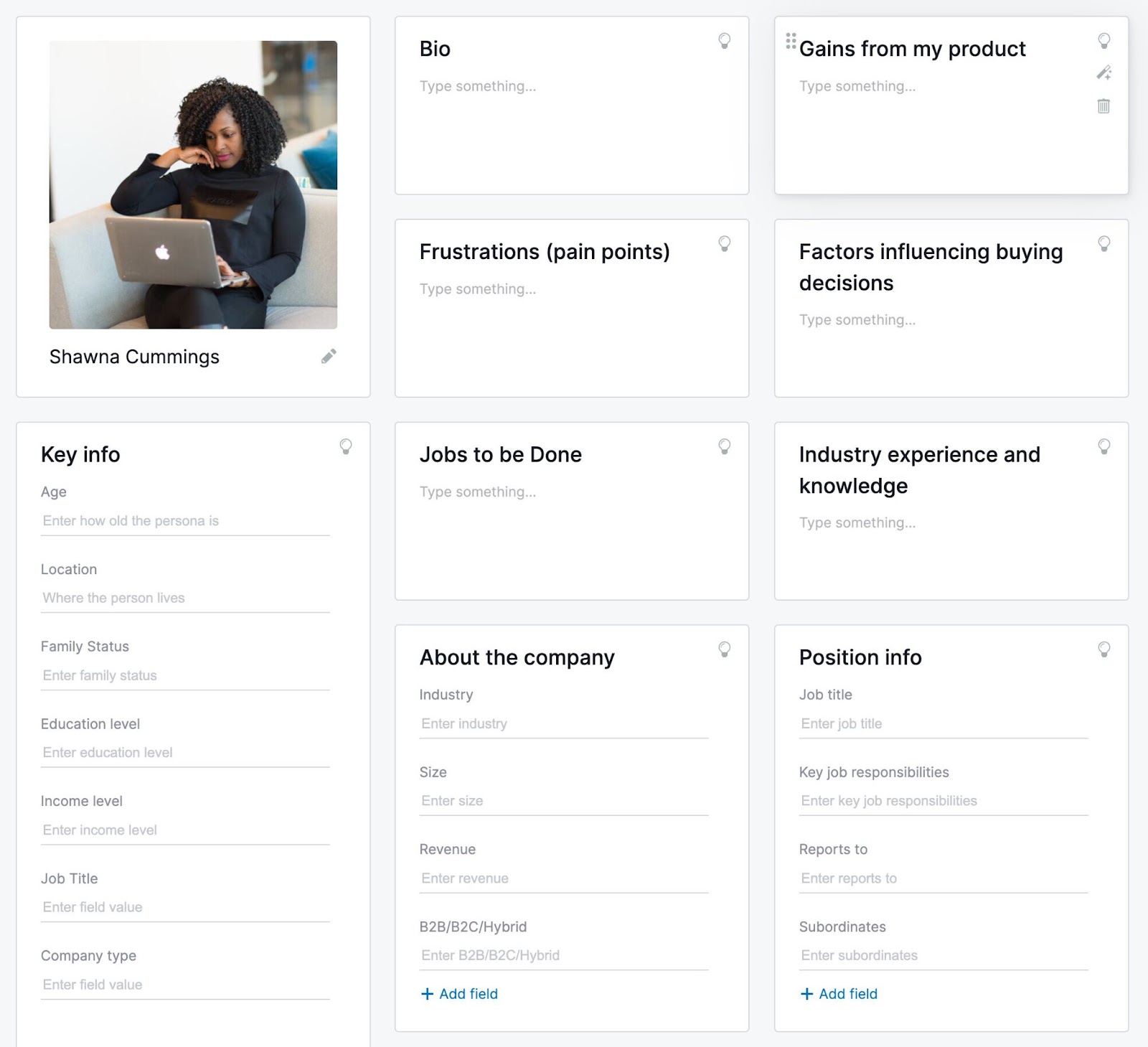
Then, use a tool like One2Target to learn more about your audience.
Add your domain and click “Analyze.”

The tool will provide four dashboards with information about your audience’s demographics, socioeconomic status, behaviors, and more.
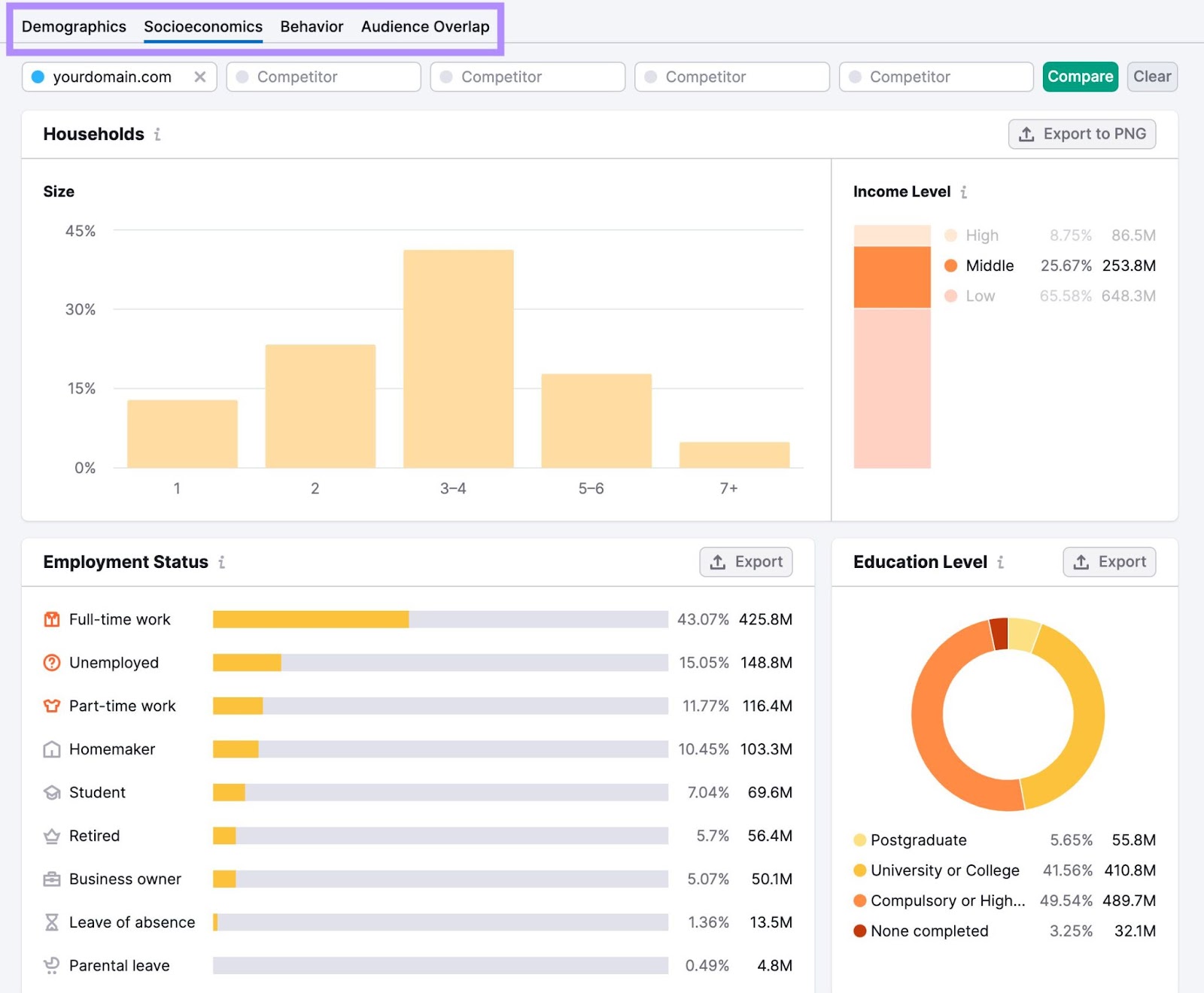
Use this data to segment your audience. Then, divide prospects into different groups based on their similarities and differences.
For example, you can segment them by location, industry, education level, budget, etc. Or a combination of characteristics.
Then, create different customer personas for each segment using the customer persona templates.
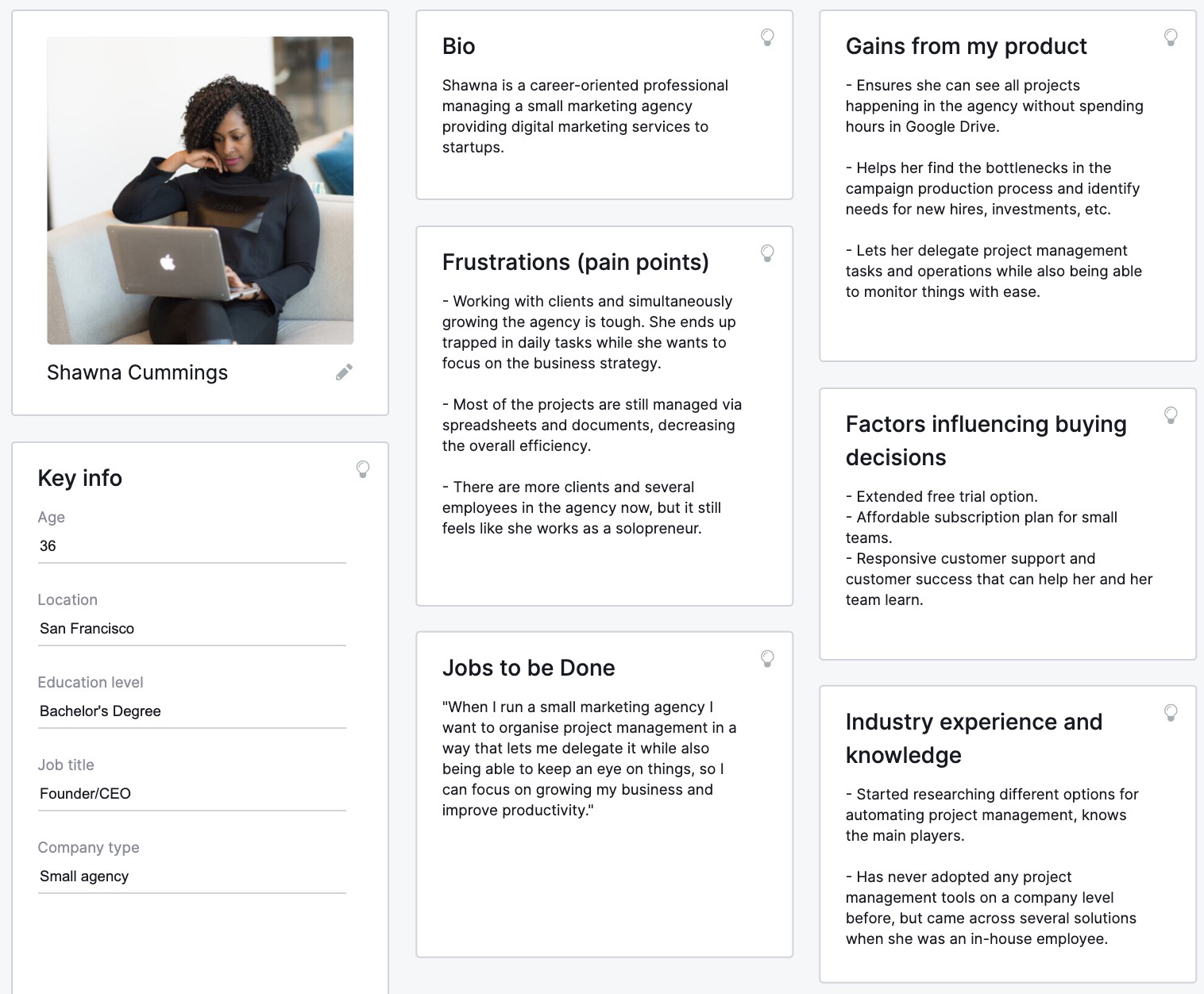
Finally, validate and update your personas. Test them with real customers and prospects. And get feedback from your sales and customer service teams.
And update your personas regularly to reflect any changes in your market and customer behavior.
3. Find Your Competitors and Analyze Their Strategies
One of the best ways to improve your SaaS SEO performance is to learn from your competitors.
Why?
Because they can show you what works (and what doesn’t) in your niche. So you can capitalize on their weaknesses and replicate their strengths.
But how do you find and analyze your competitors?
Here’s how:
Open Organic Research, enter your domain name, and click “Search.”
Then, choose the “Competitors” tab to see a list of your top organic search competitors.
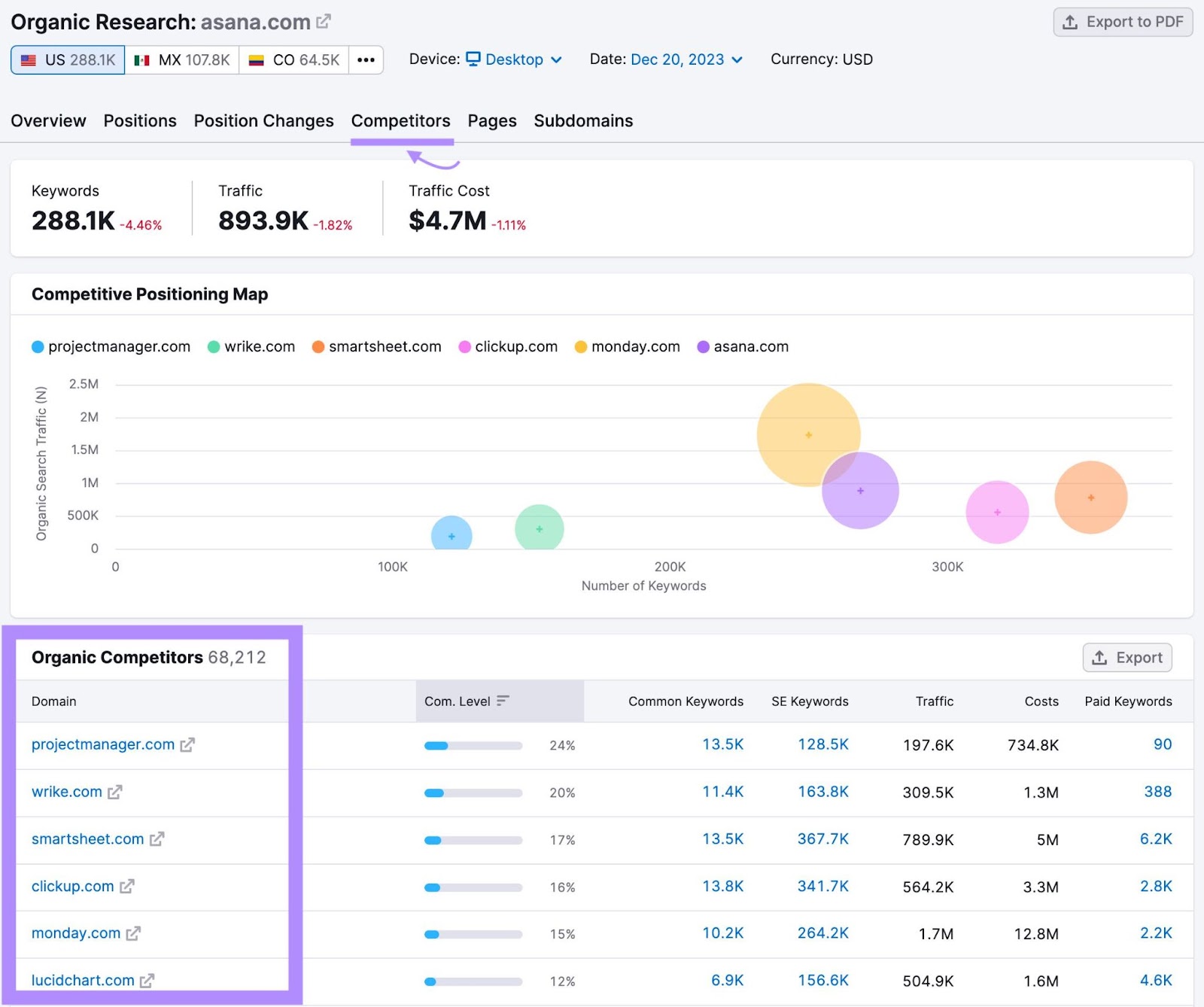
Click on any competitor in the chart to learn more about their organic traffic trends, top keywords, top pages, and more.
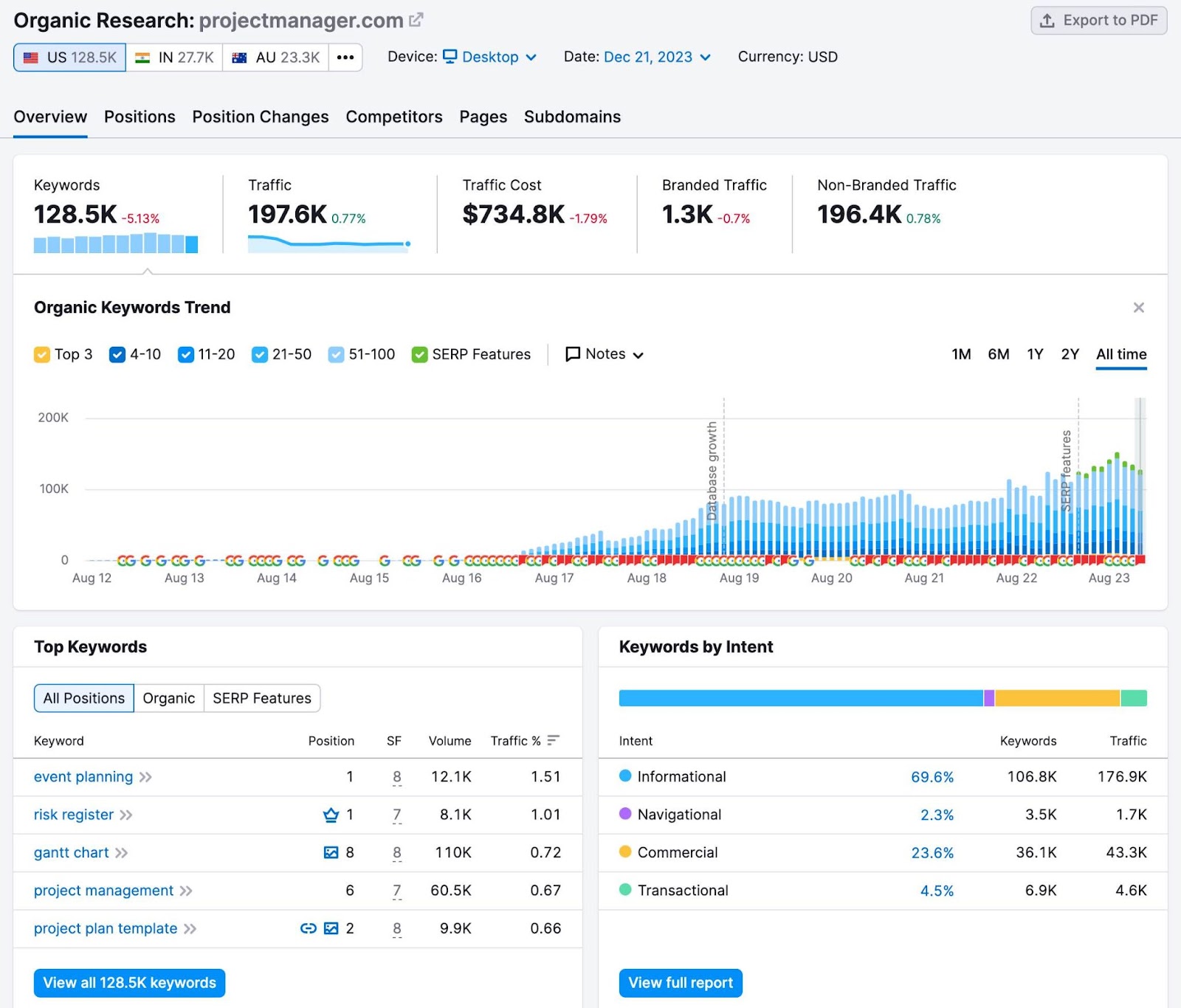
Then, find keywords your competitors rank for but you currently don’t.
To do this, use Keyword Gap. Enter your domain (and up to four competitor domains) and click “Compare.”
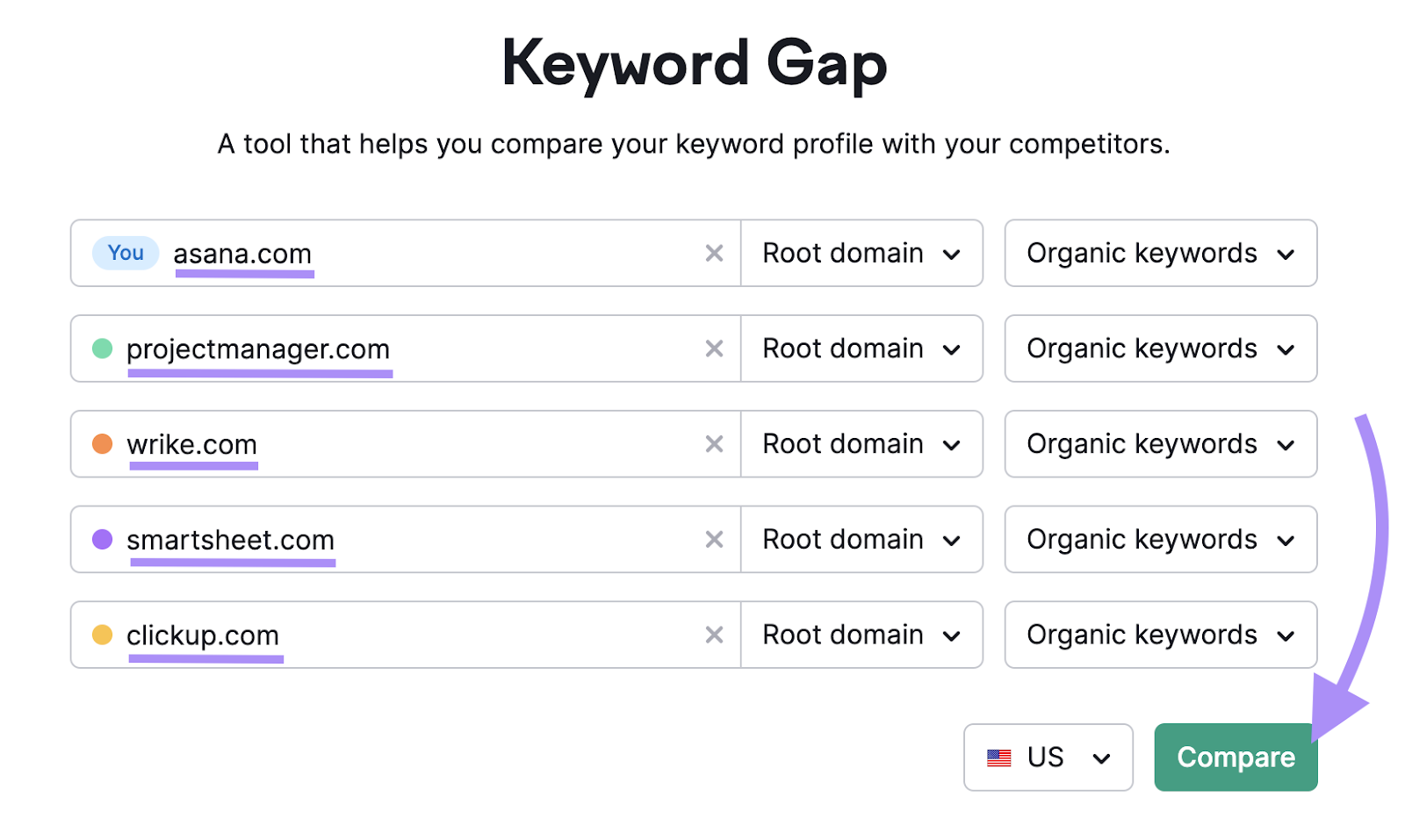
Scroll down to the table and select “Missing.” This will only show keywords you don’t rank for but your competitors do.
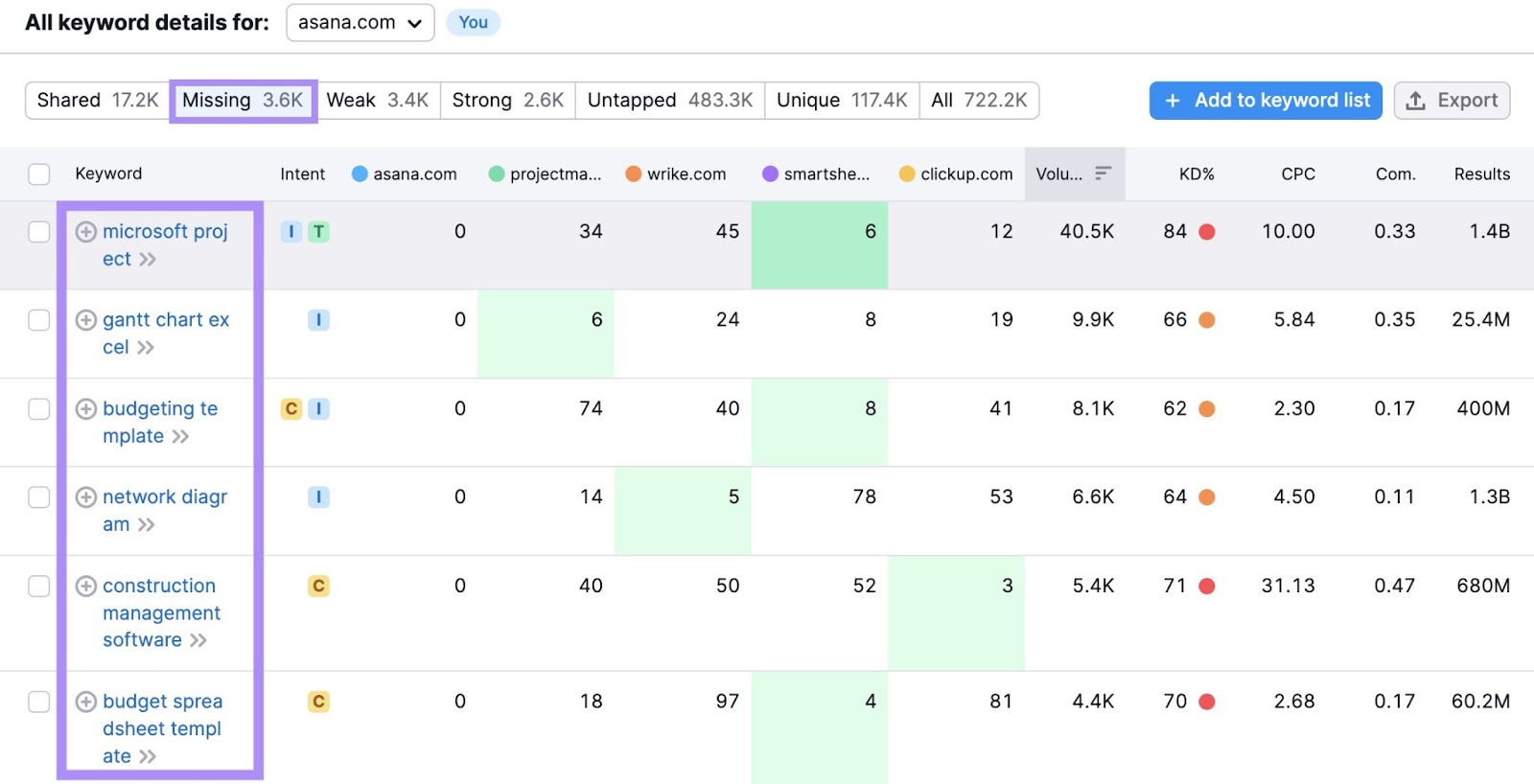
You can also conduct a backlink gap analysis to find sites linking to your competitors but not to you.
Open the Backlink Gap tool, add your domain, add your competitor’s domains, and click “Find prospects.”
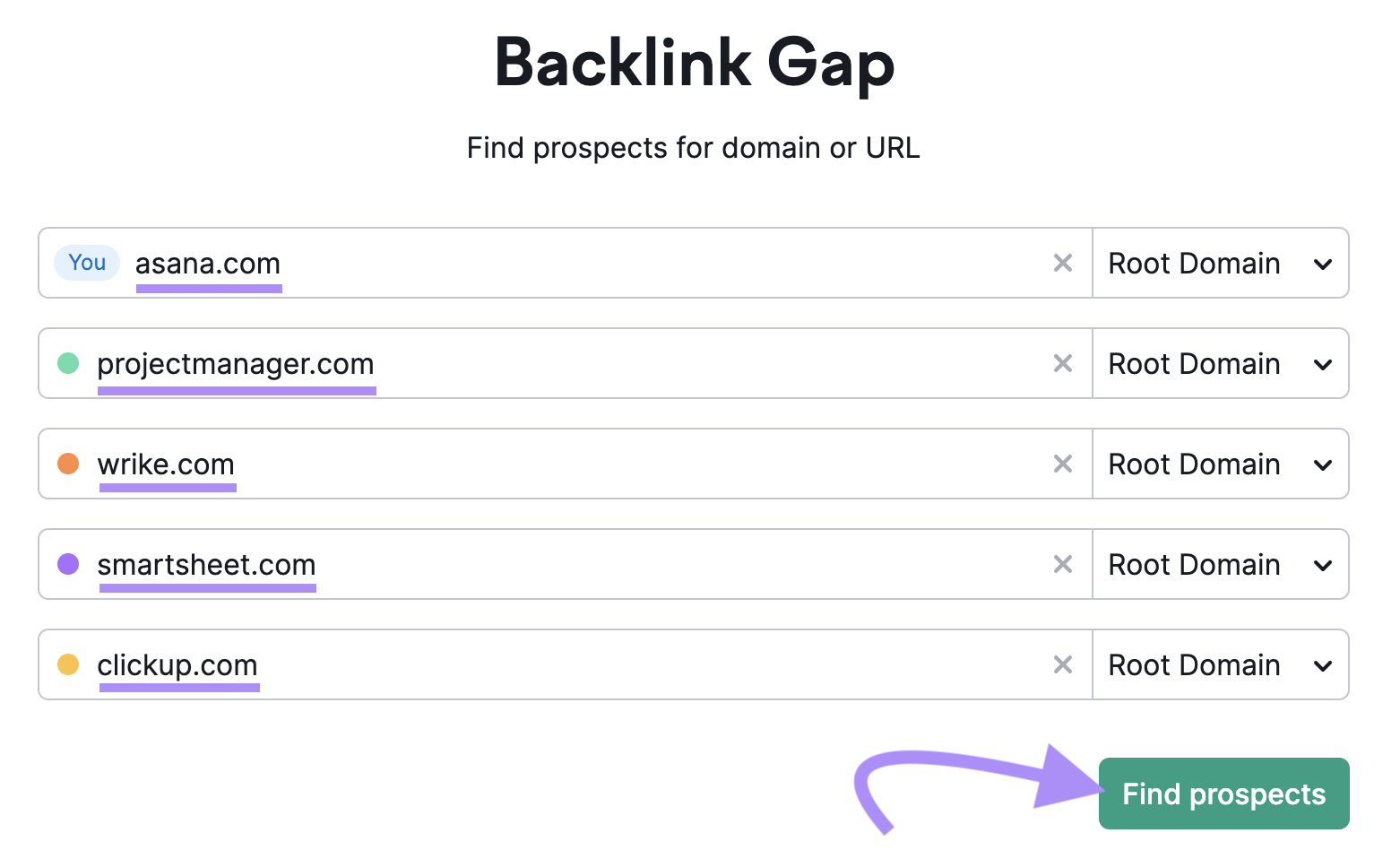
The table below shows the referring domains that send backlinks to the competitors you entered.
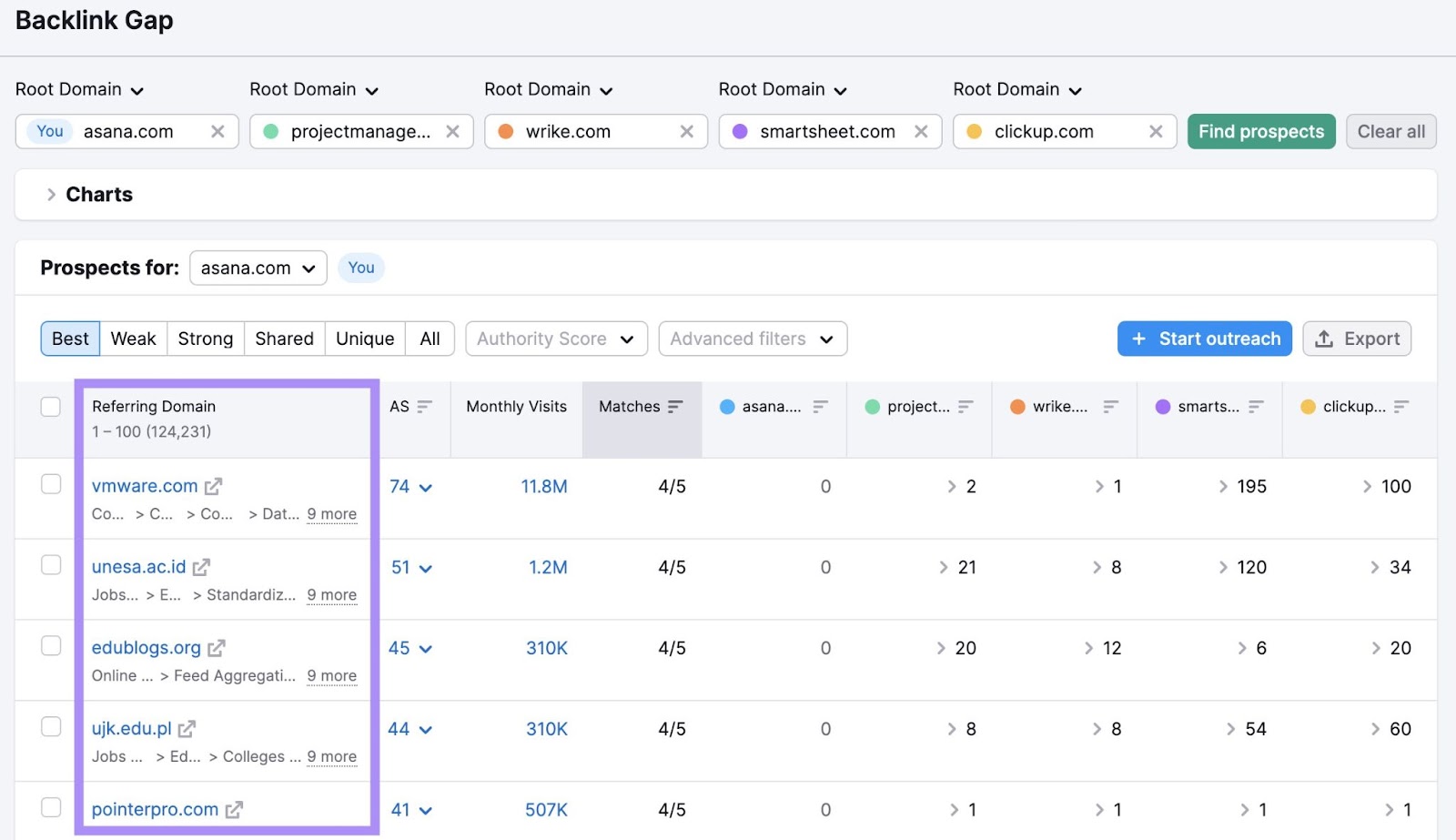
You can get more specific information about the links and URLs from each referring domain by clicking on the drop-down arrows.
This will show the domain’s Authority Score (a number out of 100 that indicates how reputable a site is), anchor text (the clickable text used for the link) and target URL, the **** the backlink was first found, and more.
Like this:
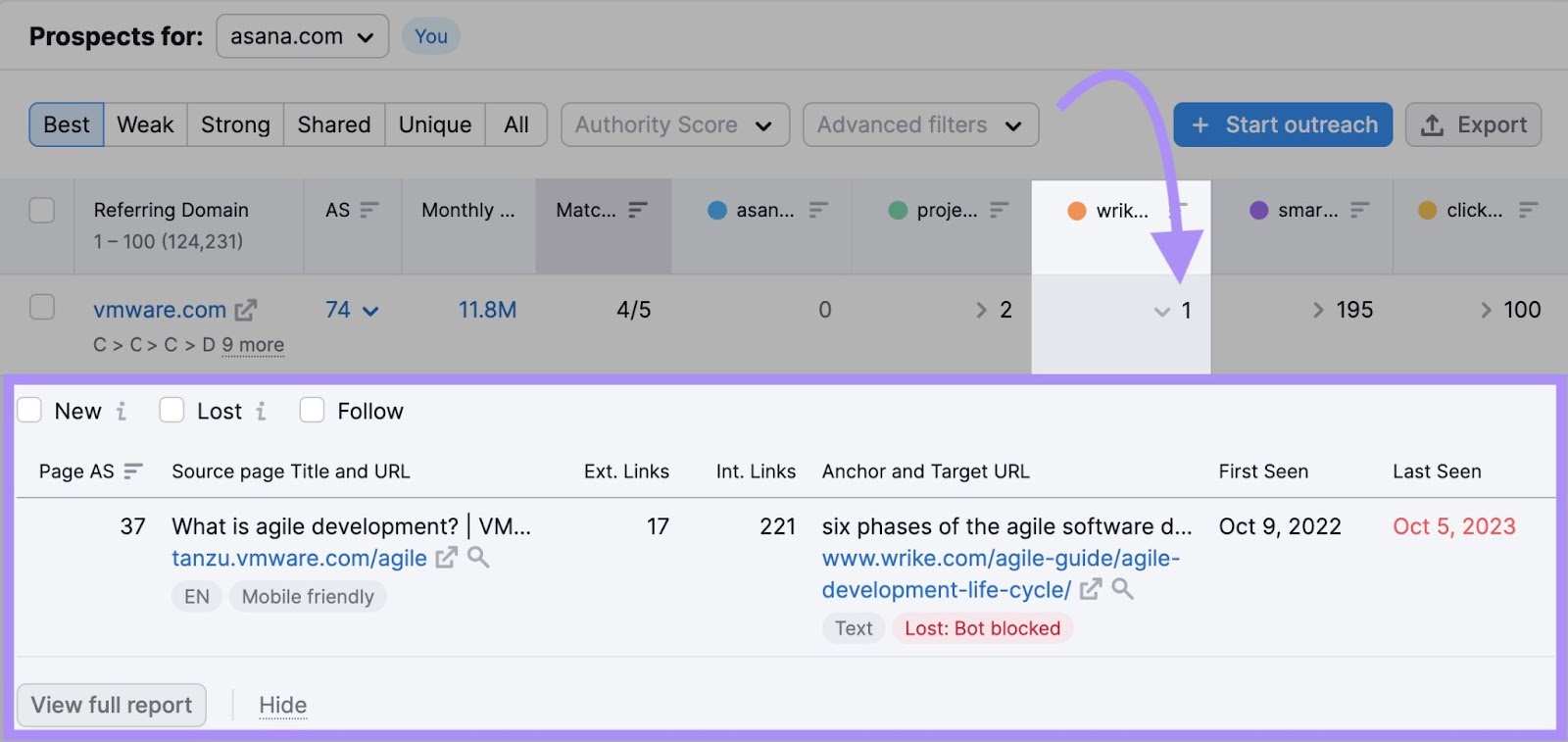
Now, you have a list of sites you can reach out to for backlinks to your content.
All of this probably sounds extensive. And it should be extensive.
You’ll want to know as much as possible about what’s driving your competitors’ strategies. Then, you can feed this insight into your own roadmap.
Further reading: What Is a Competitor Analysis & How to Do It
4. Build a Keyword List Around Pain Points
One of the secrets to SaaS SEO is to understand the problems or challenges your target personas have. And how your product can solve them.
That way, you can create content that attracts and educates potential customers at the top of the funnel.
Top-of-the-funnel keywords are usually informational in nature. And often have high search volumes but low conversion rates.
But that’s OK.
The goal now is to bring people in to build awareness and trust with them.
Here’s how you can start:
Brainstorm the common questions, pain points, or goals your personas have related to your product or niche.
For example, if you offer a sales CRM software (like Pipedrive), you might think of questions like:
- How do you build a sales pipeline?
- What is a sales funnel?
- How do you measure and track a sales team’s performance?
For more ideas, use a keyword research tool like Keyword Magic Tool.
Open the tool and enter a seed keyword from your niche. A seed keyword is a broad keyword you can use to find other keyword ideas.
And you’ll get a table with tons of ideas based on the keyword you entered.
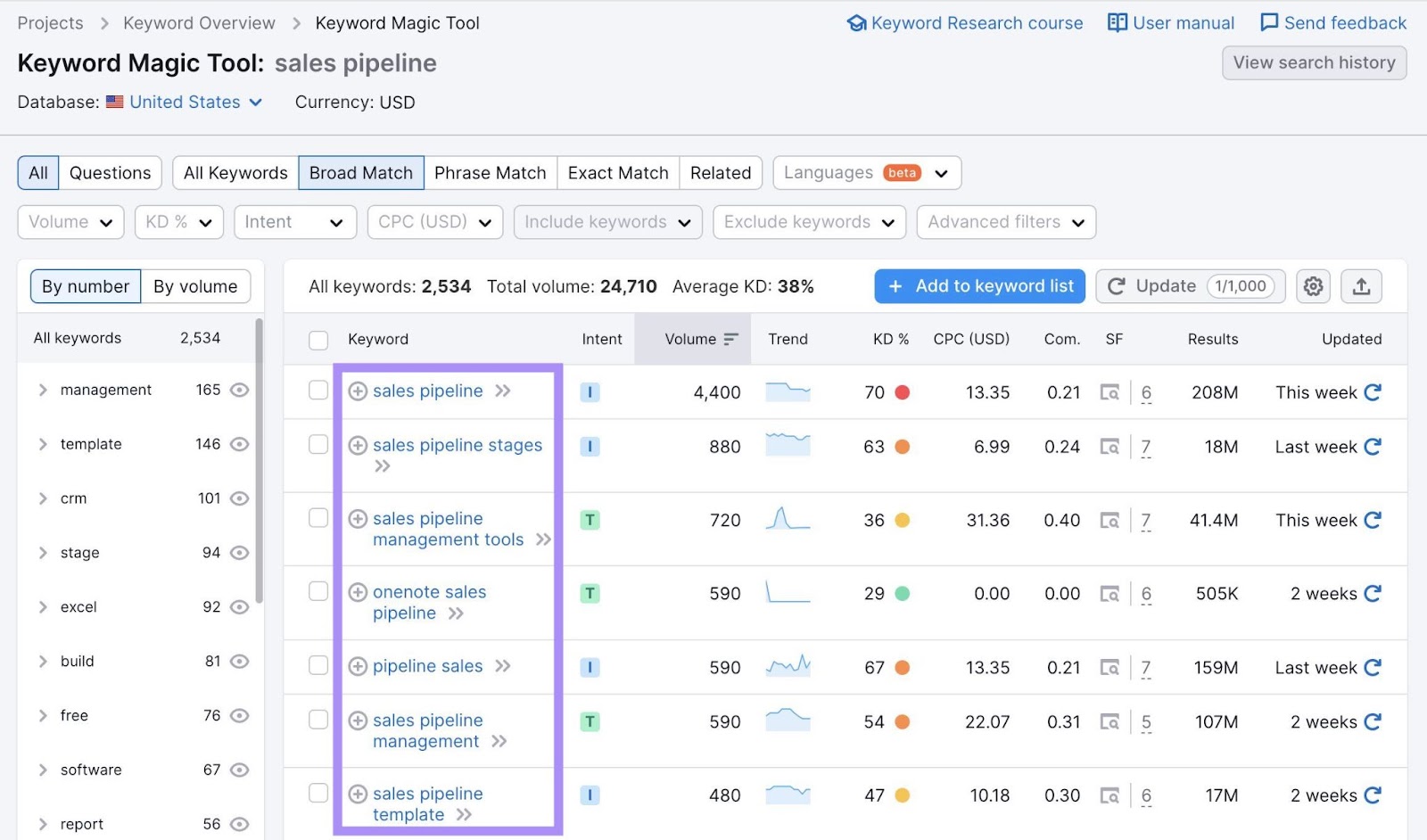
Then, click the “Intent” drop-down menu and select “Informational.”
This will show only keywords with informational intent (when searchers want to find answers to specific questions).
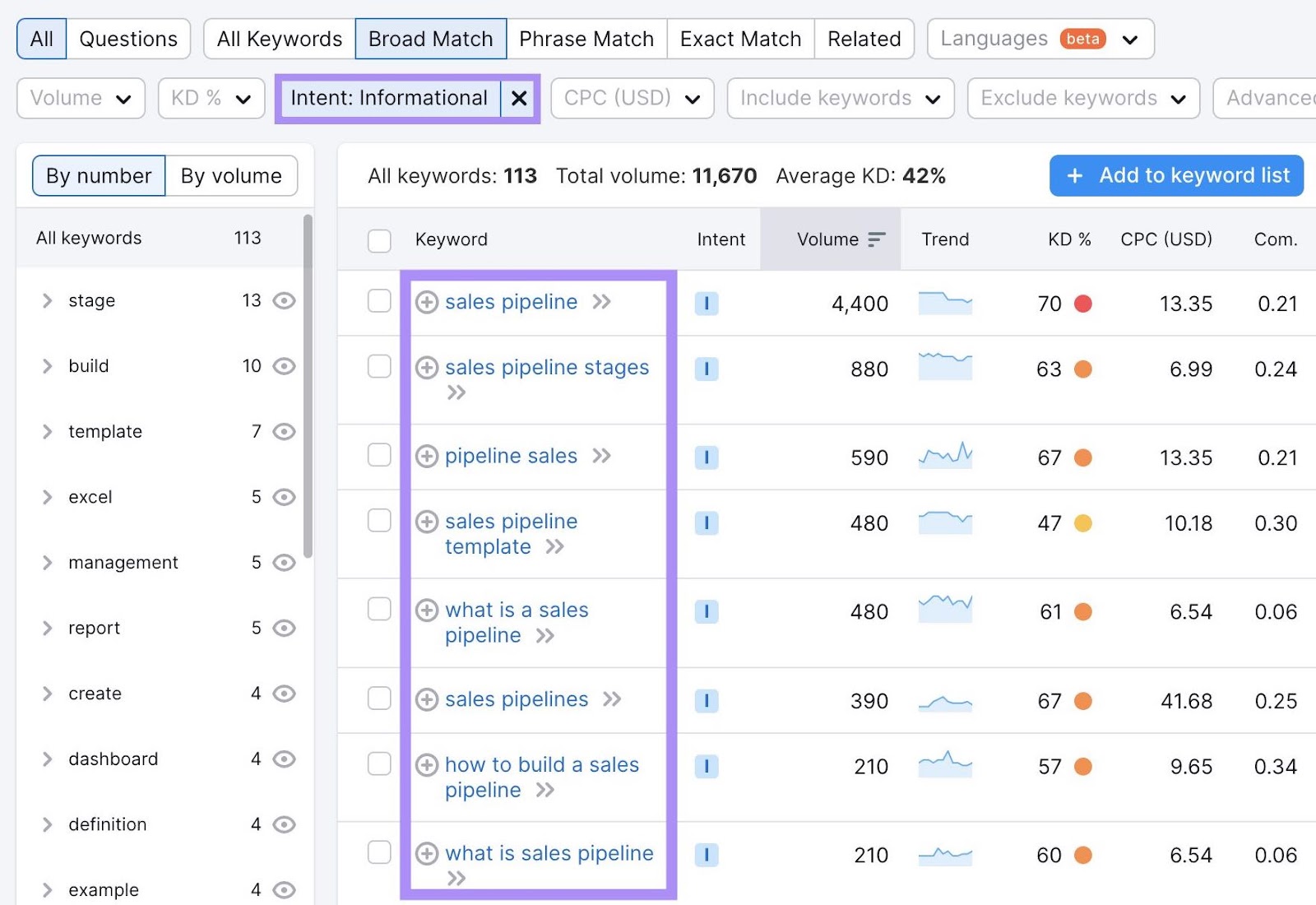
Do this for several seed keywords, and you’ll have a long list of ToFu keywords in no time.
Then, you need to create content around these keywords that provides value to your personas. And positions your product as a potential solution.
Here are some tips for creating top-of-the-funnel content for your SaaS company:
- Use the keywords in your content title, headings, URL, meta description, and body
- Mix up your content formats by using blog posts, videos, podcasts, infographics, ebooks, etc.
- Use storytelling, data, statistics, and examples
- Add clear and compelling calls to action (CTAs) that encourage your personas to take the next step
By finding and targeting keywords based on your personas’ challenges, you can create content that attracts and educates your potential customers and leads them to your product.
Further reading:
5. Find Keywords for High-Value Landing Pages
As you go down the sales funnel, you need to make sure you’re targeting the right keywords for your commercial pages.
Your commercial pages are your product and feature pages—those that provide insights into what your software offers.
Think keywords like:
- Best sales CRM
- CRM experience
- Free sales CRM
- Sales pipeline management tools
Once you’re ranking for these types of queries, you’ll be driving traffic that’s closer to converting.
These searchers are actively looking for a solution like the one that you offer, so you need to make sure you’re covering all bases and aren’t missing out on terms your personas are searching.
Find these keywords by using the “Intent” filter and selecting “Commercial” in the Keyword Magic Tool.
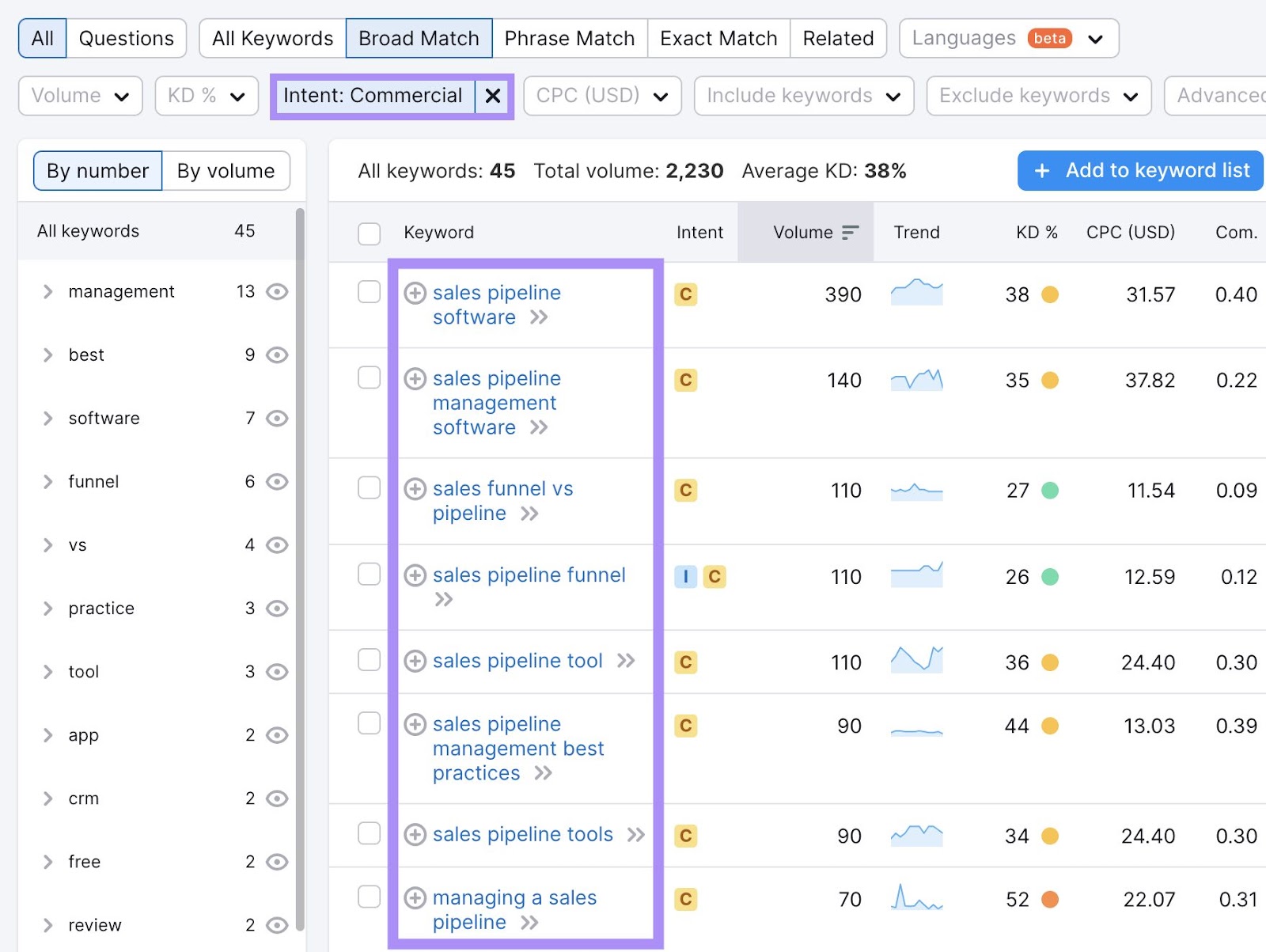
Then, optimize your landing pages for these keywords. By using them in natural and relevant ways.
For example, include your keywords in your page title, meta description, headings, subheadings, body text, images, and calls to action.
You should also use synonyms, variations, and related keywords to avoid keyword stuffing (an outdated tactic meant to “trick” search engines) and improve relevance.
6. Build Out a Comparison Keyword Plan
The next step in your SaaS SEO strategy is to target comparison keywords.
Essentially, “[you] vs. [them]” keywords.
Why?
Once your prospects get lower down in the sales funnel, there’s a good chance they’ll be comparing solutions. Hopefully, one of these is yours.
These comparison keywords are important for a few reasons:
- People who search for these keywords are usually getting ready to buy—they just need a little push
- They help show how your product is different from (and better than) your competitors
- They help attract qualified traffic and leads—these people know you exist and are more likely to purchase
You can also find these keywords with the Keyword Magic Tool.
Just search for your product name, click the “Include keywords” filter, type “vs,” and click “Apply.”
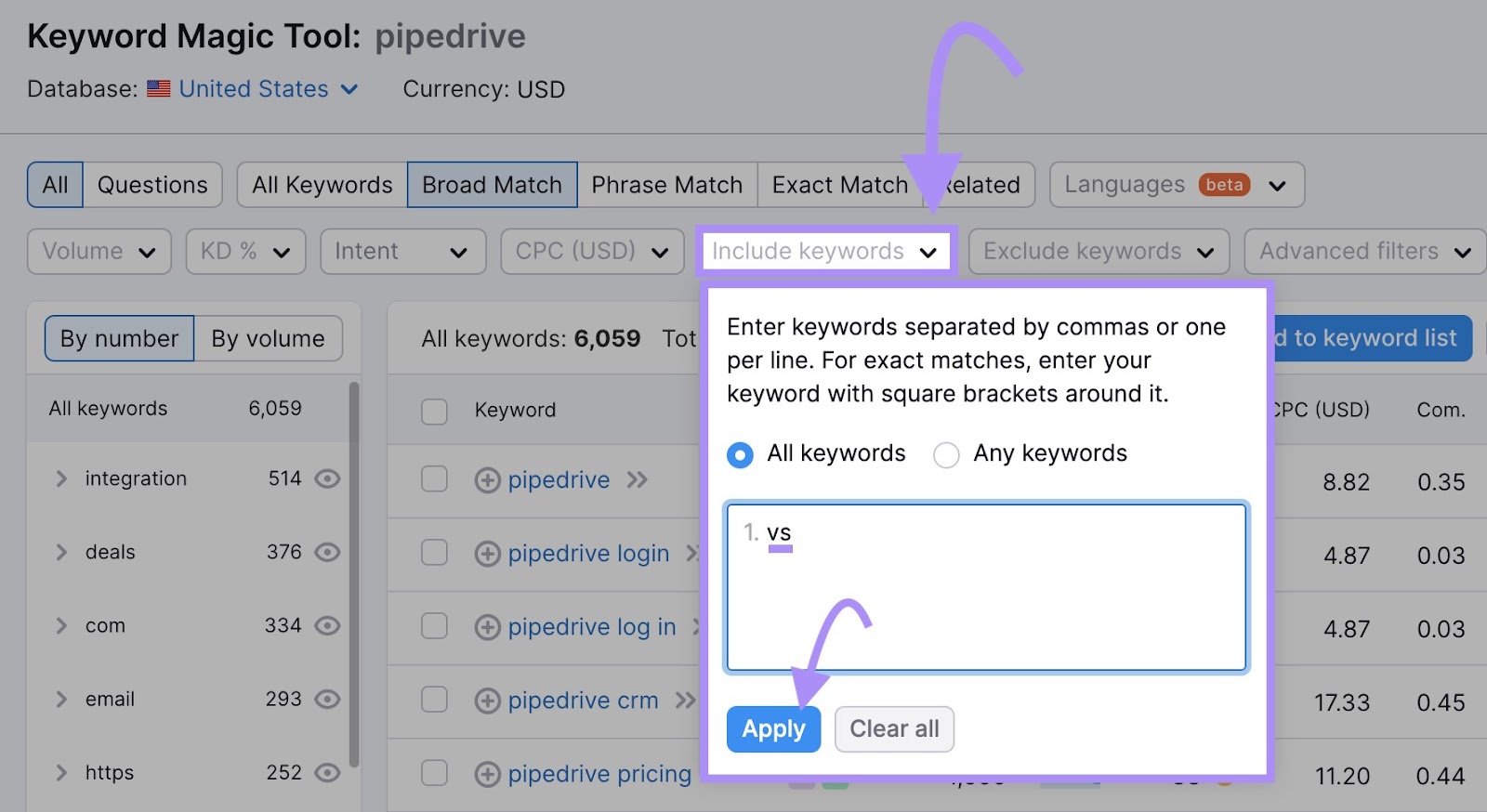
And you’ll get a filtered list like this:
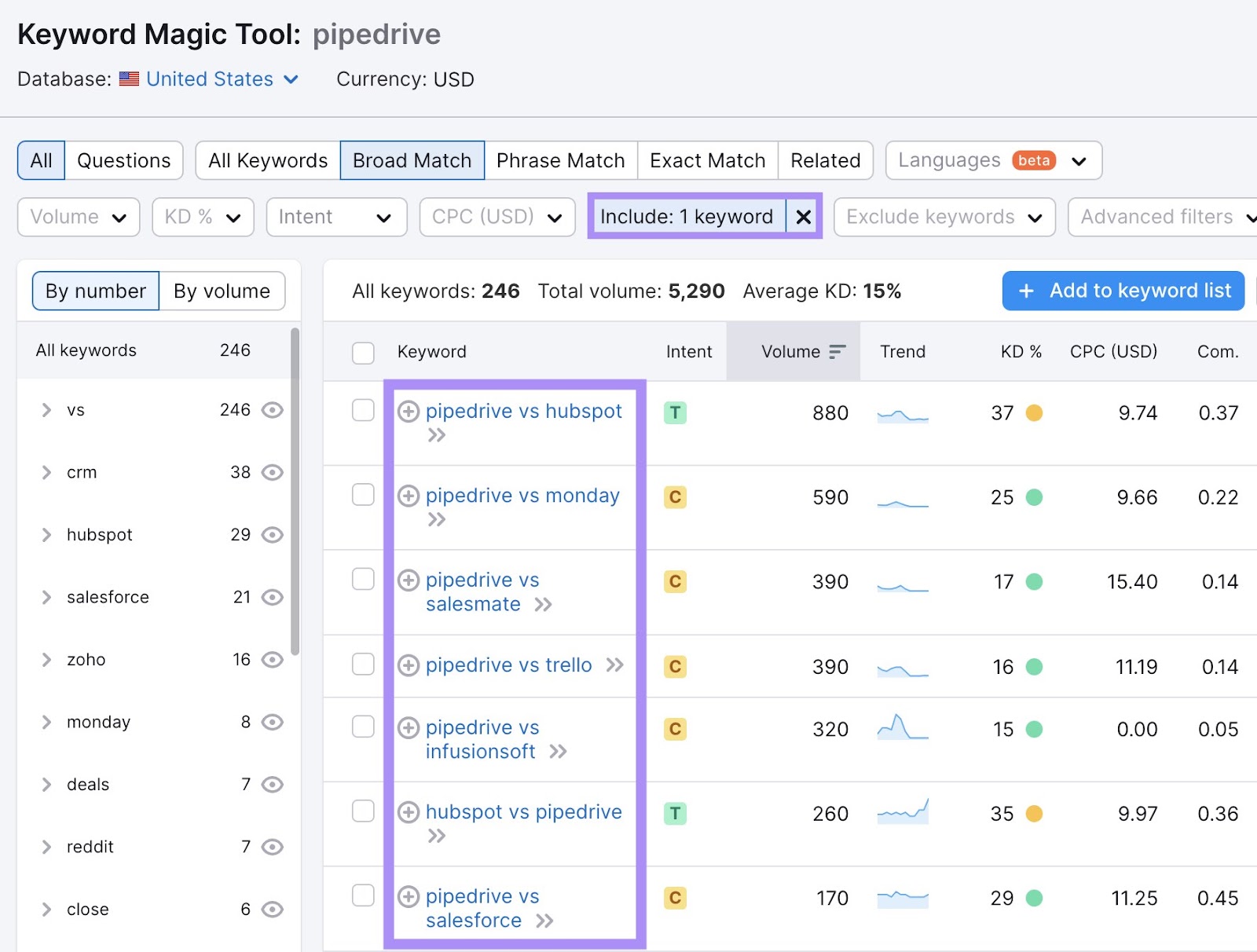
Once you have a list of comparison keywords, create content for them.
Here are some tips to do that:
- Use the keywords in your page title, meta description, headings and subheadings, body text, and images
- Present the facts and features for both products without being overly promotional or negative
- Use a clear and consistent format (like a table, a list, or a chart) to compare the products
- Clearly explain how your product can solve the user’s problem or meet their needs
- Provide a clear and compelling call to action, such as a free trial, a demo, or a discount
Here’s a great example from Pipedrive that compares Pipedrive vs. HubSpot:
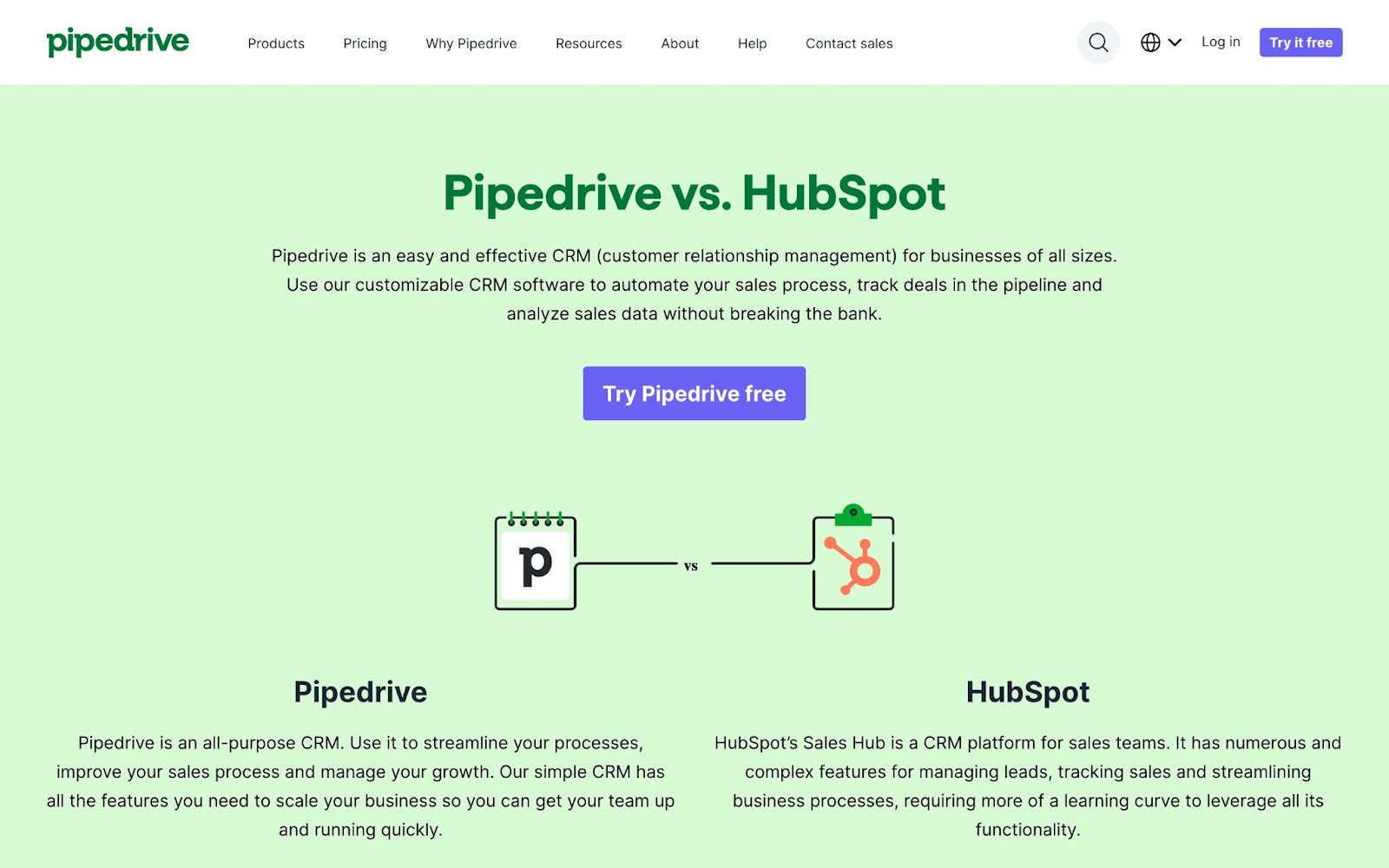
Even if there’s low search volume, it’s important to capture these lower-funnel searches that can persuade users to convert.
Get in there first before your competitor does. And if they’re already targeting these queries, make sure your page is better.
7. Create Better Content Than Your Competitors
Content is the backbone of any SaaS growth strategy. It helps you rank for relevant keywords, attract qualified traffic, and convert visitors into customers.
But creating content isn’t enough. You also need to create better content than your competitors.
First, you need to see what’s already working for them.
Open Organic Research, enter any competitor’s URL, and click “Search.” Then, head to the “Pages” tab.
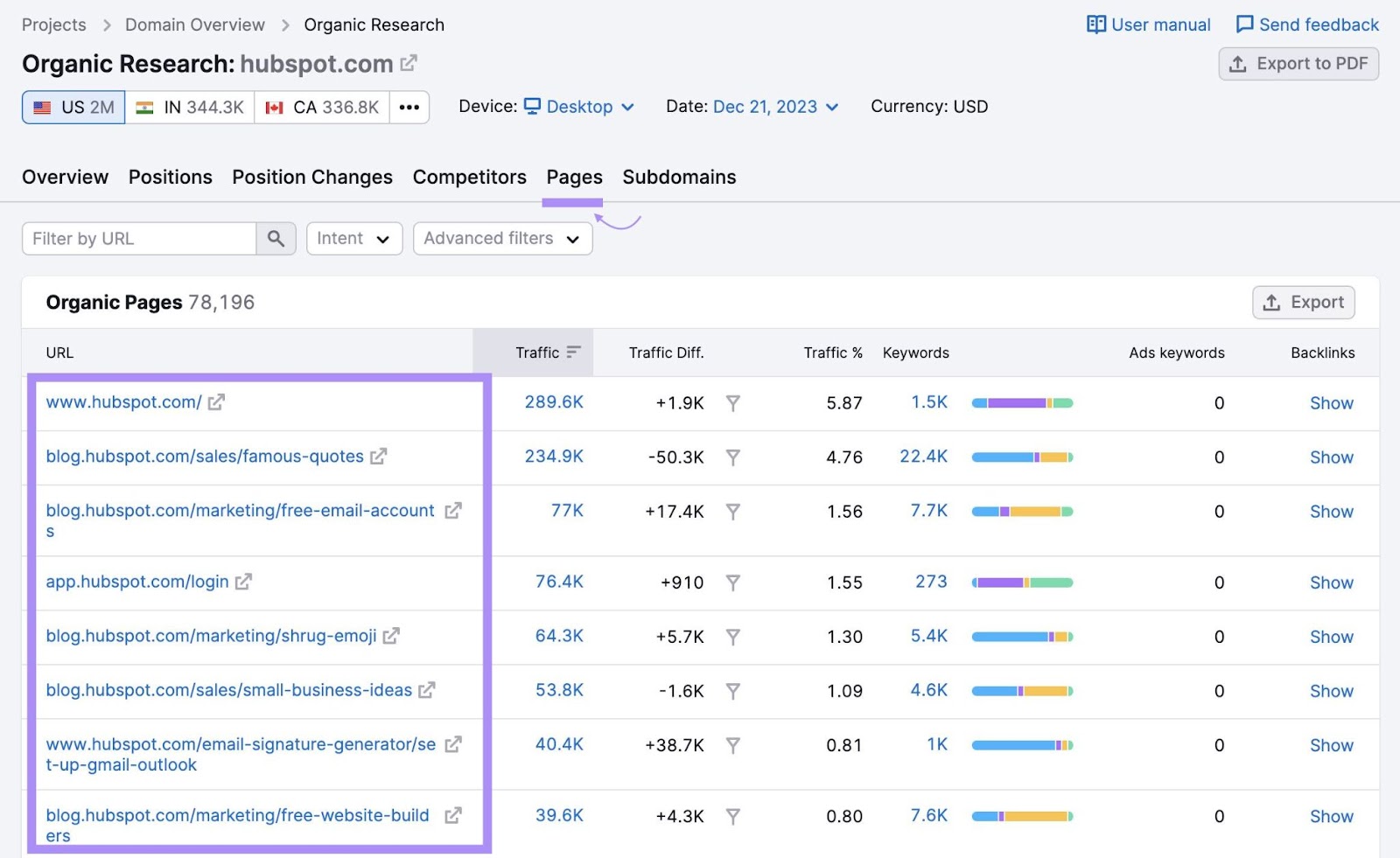
These are all of your competitor’s pages sorted by traffic. Take a look at the best-performing pages and look for patterns.
For example, consider:
- Are they mostly blog posts? Or something different?
- Is the content short-form or long?
- Do they use lots of videos?
Use the answers to these questions to guide your content strategy. Replicate what’s already working in a better way.
Here are some tips to help you create better content:
- Write for humans—not robots. Write in a clear, conversational, and engaging tone. Use headings, bullets, images, and charts to break up your text and make it easy to scan. Avoid filler, jargon, and errors.
- Deliver value to your readers. Don’t just pitch your product or service. Solve your readers’ problems, and show them how you can help them. Provide practical tips, insights, examples, and case studies.
- Optimize your content for search engines. Use your target keywords and related terms in your content, but don’t overdo it. Use them naturally and in context. Include them in your title, headings, URL, meta description, and image alt text.
Further reading: What Is Quality Content & How to Create It
8. Leverage On-Page & Technical SEO
On-page SEO (optimizing your webpages for users and search engines) and technical SEO make sure that your site is fast, secure, user-friendly, and easy to crawl.
And they can make or break your success in SaaS SEO.
That’s why you need to optimize these key on-page and technical SEO factors:
- Site speed. Site speed is how fast your website loads on different devices and browsers. It affects your user experience, conversion rates, and rankings.
- Mobile-friendliness. Mobile-friendliness is how well your site adapts to different screen sizes and orientations. Mobile SEO affects user experience, conversion rates, and rankings. So, make sure your website is responsive, easy to navigate, and readable on mobile devices.
- HTTPS. HTTPS is the secure version of HTTP, the protocol that transfers data between your website and your visitors. It encrypts your data and protects it from hackers and eavesdroppers. And it affects user trust, conversion rates, and rankings.
- URL structure. URL structure is how your site’s pages are organized and named. And it’s a key factor for user experience, crawlability, and rankings. Be sure that your URL structure is simple, descriptive, and consistent.
- Meta tags. Meta tags are snippets of code that provide information about your site’s pages to search engines and users. They also affect crawlability, click-through rates, and rankings. So, aim for meta tags that are relevant, unique, and optimized.
To check your site for on-page and technical SEO issues, use Site Audit.
The tool scans your site for 140+ technical site health and SEO mistakes. And provides a list of issues that makes it easy to see where your site is struggling.

Finding and fixing these issues will help boost your SaaS website’s SEO performance.
Further reading: How to Perform a Complete SEO Audit
9. Earn High-Quality Backlinks
Backlinks are links from other websites that point to your website.
They’re one of the most important ranking factors for SEO. Because they signal to search engines that your site is trustworthy, authoritative, and relevant.
But not all backlinks are equally valuable.
You want to earn backlinks from reputable, relevant, and popular websites. These are high-quality backlinks that can boost your SEO and drive more traffic to your site.
And you can earn these backlinks through link building—which includes tactics like:
- Content marketing
- Email outreach
- Broken link building
- Unlinked brand mentions
- PR
A great place to start is with the Link Building Tool.
Follow the Link Building Tool configuration guide to add your URL, the keywords you want to rank higher for, and your competitors.
And the tool will show a long list of prospects you can reach out to for backlinks.
Like this:
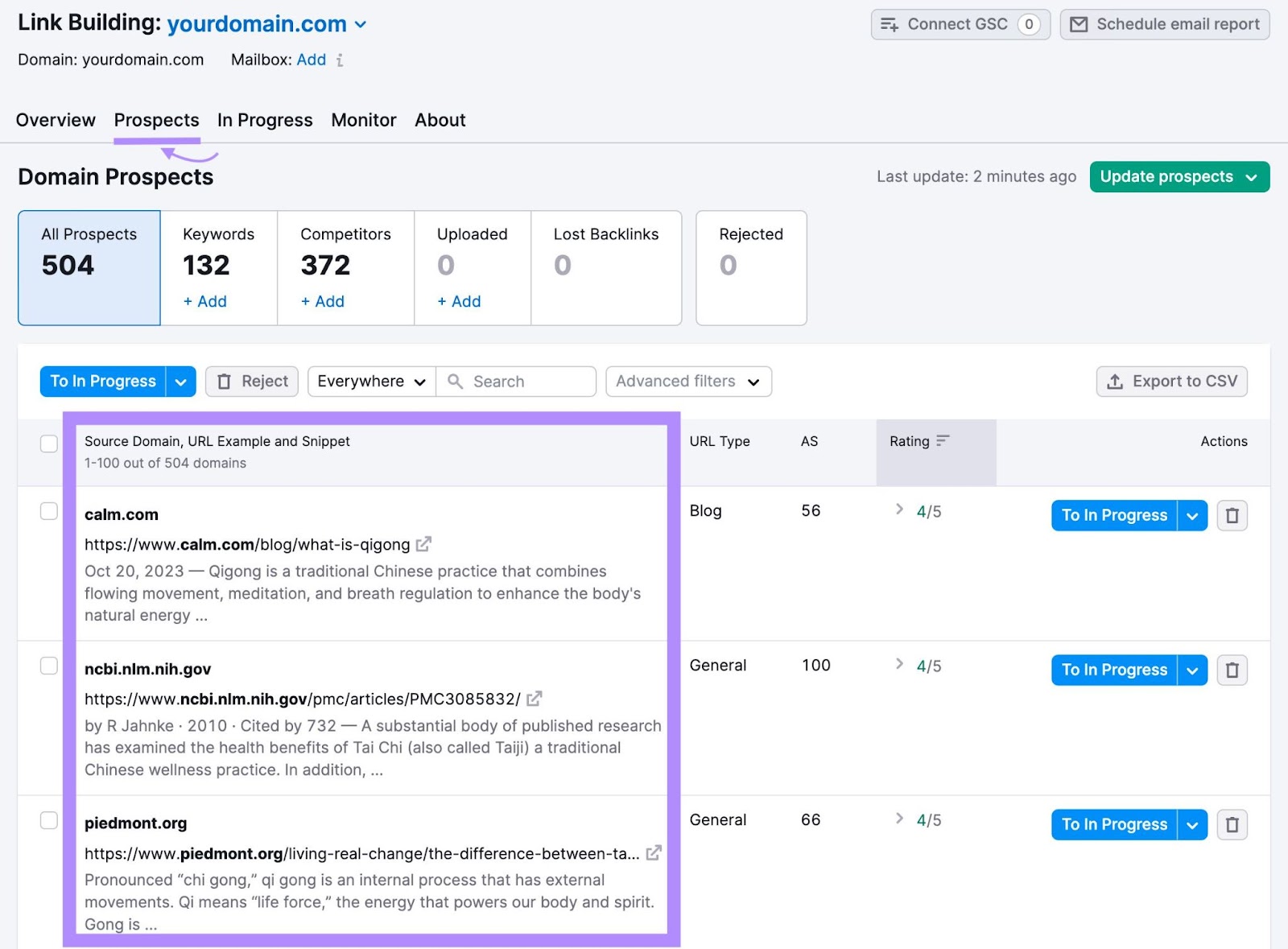
Further reading: Link Building Strategies: 8 Ways to Build Links
Ensure Your SaaS SEO Strategy Is Backed by Data
You just learned how to create and execute a successful SEO strategy for SaaS companies.
But you’re not done yet.
You need to track your performance, find out what works and what doesn’t, and make smart decisions based on data.
How do you do that?
The answer is simple: Use the right tools.
Sign up for a free Semrush account and you’ll be able to:
- Find and target the most valuable keywords
- Discover competitor strengths and weaknesses
- Audit and improve on-page and technical SEO issues
- Create and publish high-quality content that ranks and converts
- Build and monitor your backlink profile and authority
- Track and report on your SEO performance
Plus more.
This post was updated in 2024. Excerpts from the original article by James Brockbank may remain.
Source link : Semrush.com
